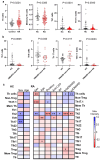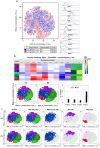Th Cell Phenotypes and Their Correlations with Disease Activity in Patients with Rheumatoid Arthritis
- PMID: 40565964
- PMCID: PMC12194616
- DOI: 10.3390/jcm14124220
Th Cell Phenotypes and Their Correlations with Disease Activity in Patients with Rheumatoid Arthritis
Abstract
Objectives: This study compared the frequencies of circulating CD4+ T helper (Th) cell subsets in rheumatoid arthritis (RA) patients and healthy controls (HCs) and investigated their relationship with RA disease activity. Methods: Peripheral blood samples and demographic/clinical data were collected from 75 RA patients and 28 HCs from the A3BC Biobank. Flow cytometry was utilized to identify cell subsets. Data were analyzed using FlowJo and GraphPad Prism. Results: RA patients displayed altered Th cell subset frequencies compared with HCs, including a higher overall proportion of Th cells (p = 0.02) but lower proportions of memory Th (p = 0.03), Th1 (p < 0.0001), and Th17.1 (p = 0.004) cells. In DMARD-naïve RA patients (n = 16), lower proportions of Th1 (p = 0.0005), Th9 (p = 0.04), and Th17.1 (p = 0.003) cells, alongside a higher Th17 cell proportion (p = 0.017), were observed compared with those in HCs. Further analysis of matched treatment-naïve, new-onset RA patients and HCs confirmed these findings. Within the RA cohort, lower proportions of Th1 (p = 0.002) and Th17.1 (p = 0.025) cells and a higher proportion of Th2 cells (p = 0.015) were correlated with increased disease activity. Inverse correlations were also found between the proportions of Th1 (p = 0.002), Th9 (p = 0.024), and Th17.1 (p = 0.00017) cells and CRP levels in RA patients. Conclusions: This study demonstrates an imbalance in circulating Th cell subset frequencies in RA patients compared with those in HCs, with notably lower Th1 and Th17.1 cell proportions in RA patients. Decreased frequencies of these cell subsets were linked to increased disease activity, indicating that restoring the balance of Th cell subsets could be a potential therapeutic strategy for RA.
Keywords: C-reactive protein; Th cells; anti-cyclic citrullinated peptide; disease activity; erythrocyte sedimentation rate; rheumatoid arthritis; rheumatoid factor.
Conflict of interest statement
The authors declare no conflicts of interest.
Figures






Similar articles
-
Plasticity deficits of Tregs remodeling toward Th1-like and Th17-like Tregs in individuals with type 1 diabetes.J Endocrinol Invest. 2025 Jun;48(6):1495-1509. doi: 10.1007/s40618-025-02557-w. Epub 2025 Mar 3. J Endocrinol Invest. 2025. PMID: 40029535
-
Serum tryptophan-kynurenine metabolites served as biomarkers of disease activity in rheumatoid arthritis and linked to immune imbalance.Arthritis Res Ther. 2025 Jul 5;27(1):136. doi: 10.1186/s13075-025-03596-7. Arthritis Res Ther. 2025. PMID: 40618074 Free PMC article.
-
Comprehensive single-cell chromatin and transcriptomic profiling of peripheral immune cells in nonsegmental vitiligo.Br J Dermatol. 2025 Jun 20;193(1):115-124. doi: 10.1093/bjd/ljaf041. Br J Dermatol. 2025. PMID: 39888372
-
A systematic review of the effectiveness of adalimumab, etanercept and infliximab for the treatment of rheumatoid arthritis in adults and an economic evaluation of their cost-effectiveness.Health Technol Assess. 2006 Nov;10(42):iii-iv, xi-xiii, 1-229. doi: 10.3310/hta10420. Health Technol Assess. 2006. PMID: 17049139
-
Biologics or tofacitinib for people with rheumatoid arthritis naive to methotrexate: a systematic review and network meta-analysis.Cochrane Database Syst Rev. 2017 May 8;5(5):CD012657. doi: 10.1002/14651858.CD012657. Cochrane Database Syst Rev. 2017. PMID: 28481462 Free PMC article.
Cited by
-
Validation of a Ready-to-Use Lyophilized Kit for Labeling IL2 with 68Ga: A New Avenue for Imaging Activated T-lymphocytes in Tumor Microenvironment.J Clin Med. 2025 Aug 10;14(16):5658. doi: 10.3390/jcm14165658. J Clin Med. 2025. PMID: 40869484 Free PMC article.
References
-
- Ciccia F., Guggino G., Ferrante A., Raimondo S., Bignone R., Rodolico V., Peralta S., Van Tok M., Cannizzaro A., Schinocca C., et al. Interleukin-9 Overexpression and Th9 Polarization Characterize the Inflamed Gut, the Synovial Tissue, and the Peripheral Blood of Patients With Psoriatic Arthritis. Arthritis Rheumatol. 2016;68:1922–1931. doi: 10.1002/art.39649. - DOI - PubMed
-
- van Roon J.A., Bijlsma J.W., Lafeber F.P. Suppression of inflammation and joint destruction in rheumatoid arthritis may require a concerted action of Th2 cytokines. Curr. Opin. Investig. Drugs. 2002;3:1011–1016. - PubMed
LinkOut - more resources
Full Text Sources
Research Materials
Miscellaneous

